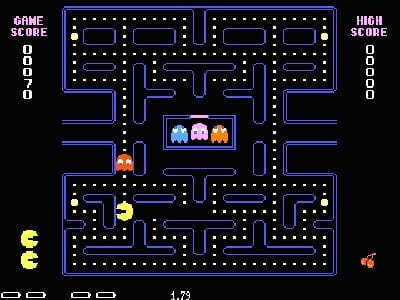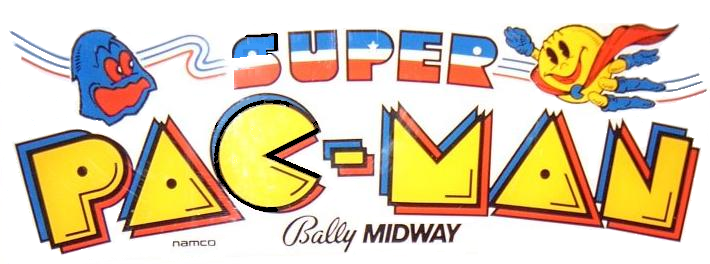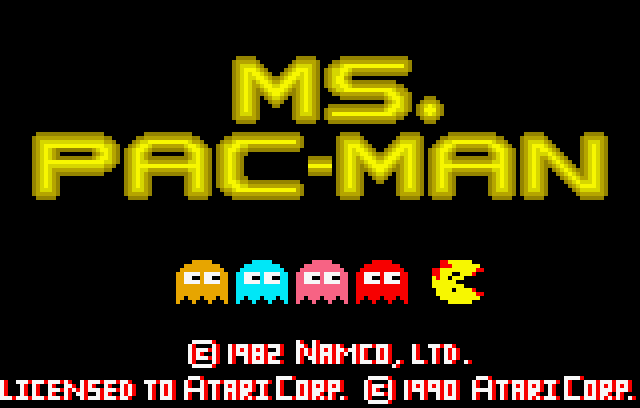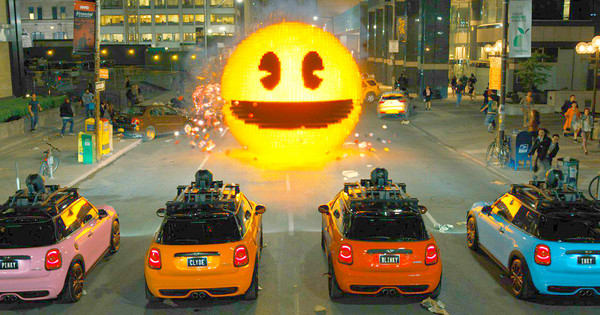240 pellets, 4 power pellets, and 4 ghosts named Blinky, Inky, Pinky, and Clyde—that is classic Pac-Man. The character of Pac-Man is one of the most well-known video game icons worldwide, perhaps second only to Mario. Pac-Man’s contribution to the gaming and arcade machines world is unprecedented, so for his 35th anniversary this year, Home Leisure Direct would like to give a proper tribute to the Pacster. We hope you enjoy the history and incredible facts surrounding this yellow circle with a triangular mouth.
Origins

Pac-Man was the brainchild of Toru Iwatani, who claims to have been inspired to create the character after seeing a pizza with a quarter of it gone. Pac-Man was originally named “Puck-Man,” but that would cause obvious problems for adolescent gamers in the West, so his name was changed from “Puck” to “Pac,” which is derived from the Japanese term “paku-paku” for munching. Perfect.
With a team of just eight people, Mr Iwatani designed and programmed the game in fifteen months. Namco showcased the game at a trade show in 1980 along with Battlezone, Defender, and Rally-X. Surprisingly, Namco did not expect Pac-Man to be that successful. In fact, the company was really pushing for the promotion of Rally-X, which they thought would be the best of the bunch. Ironically, even Defender, for which they didn’t have high hopes at all, sold better than Rally-X, but the true shocker was the splash that Pac-Man made in arcades around the world.
First in Japan, and then in the West (especially in the USA), fans’ Pac-Man fever raised the arcade game to super stardom status. In the first year alone, Namco sold over 100,000 cabinets, coming in both upright and cocktail models. Namco went on to manufacture and sell Pac-Man arcade cabinets until 1987, by which time, there had been more than 350,000 units sold. To this day, the original Pac-Man game holds the record for the highest grossing arcade game of all time.
Formula for Success
Pac-Man’s release perfectly coincided with the Golden Age of video arcades, which began in the late 1970s and ended in the mid to late 1980s. The game became a success for many reasons. First, it is very colorful and loud. It’s neon-like color scheme and “nom-nom-nom” sounds are attractive right from the start, and then they become almost addictive the longer you play.
The “rough draft” version of Pac-Man had ghosts with programmed set paths. However, clever players immediately memorized those set paths and dominated the Pac-Man game without much effort. So the Namco team ingeniously reprogrammed the ghosts to have “behaviour” in their movements. Infamously, Blinky hounds after Pac-Man with abandon. Inky tends to wander around within the vicinity of Pac-Man, especially when Blinky is nearby. Pinky tries to anticipate where Pac-Man is headed and cut him off, and Clyde seemingly moves about randomly. Actually, there is quite a bit of code behind the ghosts’ movement patterns. For those interested in this topic, this link is an excellent site to check out. Pac-Man is one of the first games to have such well-coded AI that players not only felt that they were being chased by “aware” enemies, but they also had very similar impressions of the ghosts’ personalities based on how the enemy AI acted and reacted to the player.
Another winning factor is the game’s simple yet addictive gameplay. Pac-Man is definitely an arcade game: the gameplay is the same throughout all the levels, yet each level varies in the game’s difficulty factors, and the game rewards players with points, congratulatory sound effects, and regular intermissions (cutscenes) that divide the game into manageable chunks.
Perfect from the start, Pac-Man’s video game empire was set to last for decades. Here we are thirty-five years later and still playing (and talking about) Pac-Man. New generations of gamers continue to find enjoyment in this 24kb arcade game that got its start all the way back in 1980. Astounding!
Sequels and New Directions in Gameplay

Only two years after the Pacster’s debut, gamers were demanding more. Namco was in the process of developing the official sequel, Super Pac-Man, but neither the gamers nor Midway, Namco’s North American distributor, had any patience left.
Clones upon clones of the Pac-Man gameplay formula have been produced throughout the past thirty-five years—too many to count. But the most famous example was initially known as Crazy Otto. The game blatantly copied the look and gameplay of Pac-Man. Midway bought the rights to release the game and tweaked it substantially. Without asking for Namco’s permission, Midway then proceeded to sell the unofficial sequel to arcades across the USA. Midway would go on to do this several more times for the Pac-Man series—a bad business practice that ultimately ended the relationship between them and Namco.
But Namco shouldn’t have been too upset about this first breach in trust. Midway had created a hit that was just as good (if not superior) to the original Pac-Man game. We know it as Ms. Pac-Man. It began the Pac-Man fever all over again, becoming the most successful American-produced arcade game of all time. According to Wikipedia, 115,000 cabinets were produced and sold. Unfortunately, none of these cabinets ever made it over to Japanese arcades, although Namco did reclaim the licenses and rights for the game sometime later and has since included it in many Pac-Man ports and compilations.
Ms. Pac-Man’s existence was inspired by Midway’s observations that Pac-Man was the first game with a lot of female players and fans. Midway wanted to cater to this new market by making the main protagonist female. They also didn’t want to stir up controversy, so they titled her “Ms.” Pac-Man, giving the implication that she and “Mr.” Pac-Man were married. This made the cutscenes of her and Pac-Man having a child together much more acceptable.

This games’ design choices subsequently created a backstory for Pac-Man. He was no longer just a yellow circle eating pellets and ghosts. He had a family to take care of. He was relatable. Thus, whether Namco wanted it or not, Pac-Man entered western pop culture as more than just a game. In that same year (1982), Pac-Man got his own animated series, produced by Hanna-Barbera, in which Pac-Man, Ms. Pac-Man, and Jr. Pac-Man had many adventures together in Pac-Land. Midway went on to release four more games without Namco’s permission: Pac-Man Plus (1982), Baby Pac-Man (an interesting hybrid of arcade and pinball gameplay, 1982), Jr. Pac-Man (1983), and Professor Pac-Man (1983). None of these other unofficial sequels can be considered successful. They certainly never reached the heights of popularity that Pac-Man and Ms. Pac-Man had.
Meanwhile, Namco released Super Pac-Man in 1982. It was a drastic departure from what gamers were expecting in their Pac-Man experiences at the time. Instead of pellets, Pac-Man had to gobble up various fruits to progress through the levels. In order to get to these fruits, Pac-Man either had to eat keys to open doors, or he had to eat super pellets, which enlarged his sprite and gave him the power to bust through shut doors and be invincible for a short period of time. The original power pellets were also included in this game.
Super Pac-Man was inspired by the character of Superman, and though the game got mixed reviews upon release, the concept of Pac-Man becoming “super” remained part of the mythos. Pac-Man would periodically be seen donning a cape and flying around in both video game and cartoon media from then on. But ultimately, this game was the first sign of a problem in the Pac-Man design: the original design was already perfect. For many years afterward, designers would struggle to re-invent and build upon the original game’s winning formula.
Games such as 3-Demon (1983) and Pac-Man VR (1996) tried to bring the Pac-Man gameplay into the third dimension. Pac-Man was given his first platforming game, Pac-Land, in 1984 and his first 3D platforming game, Pac-Man World, in 1999 right around his 20th anniversary. Both platforming games had multiple sequels and follow-ups, but neither series was very successful; instead, gamers felt that putting Pac-Man into a platforming game was a shoehorned effort rather than a natural progression for the series. It was a problem that would continue to plague Pac-Man for another ten years.
Perhaps the only truly successful Pac-Man sequel during this time period was Pac-Mania (1997), which had pseudo-3D graphics, up to nine ghosts on the screen at a time, and the ability for both Pac-Man and some of the ghosts to jump over one another. Another well-received game in the series was Pac-Man Vs., first released on the Nintendo Gamecube in 2003 and then bundled in the Namco Museum DS for Nintendo DS in 2007. The game is strictly multiplayer, with one player as Pac-Man and the others playing as the ghosts. Other than those two games, from 1983 until 2007, Pac-Man’s presence struggled to stay fresh in the lives of gamers, to the point that Pac-Man found himself depending on ports, clone games, guest appearances in other games, and pop culture news to stay relevant in the rapidly-changing gaming scene.
Legacy
Pac-Man will forever be known as one of video gaming’s most famous mascots. He is also part of the group of classic games made famous during the Golden Age of the video arcades. But since then, Pac-Man has continued to make news and be more than just a nostalgic character from yesteryear.
In 1982, Buckner & Garcia released an album called “Pac-Man Fever”—a term already used several times in this very article. Perhaps the song dedicated to Pac-Man hasn’t stood the test of time, but the term has. The sounds and music of Pac-Man continue to be added into songs and remixes to this day, including the ever-required dubstep remix.
Merchandising with Paccy has been enormous too: toys, lunchboxes, school supplies, clothing, bedsheets, and even cereal. A new wave of merchandising and games began after Pac-Man got his second animated series, Pac-Man and the Ghostly Adventures, in 2013. Pac-Man was given a new image, placed in a new and futuristic Pac-Land, and surrounded by new characters, including re-designed versions of the four main ghosts.
One exceptionally popular topic for Pac-Man fans is the world record for the Pac-Man high score. Billy Mitchell was the first gamer to get a perfect score in Pac-Man in 1999. In order to achieve a perfect score, for each of the 255 levels, he had to eat all 240 pellets, all four ghosts for each power pellet (sixteen ghosts eaten in all), and all fruit that appeared onscreen. Billy Mitchell's’perfect score was 3,333,360 points. But he no longer holds the world record. How does one beat a perfect score? By doing it faster. Currently, the record holder is David Race, who beat the game with a perfect score in just three hours and twenty-eight minutes and forty-nine seconds!
The internet has also taken part in keeping Pac-Man fever alive. One of Google’s most famous logo designs was created in celebration of Pac-Man’s 30th Anniversary. You can still play it here. Also, there’s a fan-made website called World’s Biggest Pac-Man that is an ever-expanding Pac-Man “level” created by players for players. But most significantly, the internet has grown a whole new generation of gamers obsessed with leaderboards and achievements—a perfect ecosystem for Pac-Man to make a comeback.
Not only has the original game done just that (check out the latest releases of the original on iOS and Android), but a new game, released in 2007 and then re-released in 2013, has brought back Pac-Man fever bigger and better than ever before. That game is PAC-MAN Championship Edition and Championship Edition DX+. It can be purchased on all major consoles and platforms (except the Wii U, for some stupid reason), and it is super addicting. Multiple modes, plenty of different mazes, and an improvement on the gameplay of the original—Championship Edition is fast-paced, chaotic Pac-Man glory at its finest. It has leaderboards, achievements, and unlockables—everything required for the gamer of this gaming era (which started sometime during the mid-2000s). It is a fantastic game that definitely deserves your attention. So go play it already!
This Year for Pac-Man

Not as many developments have happened for this anniversary as the last one in 2010, but Pac-Man is still getting love from developers and fans alike. For example, Pac-Man is a main character in the 2015 movie Pixels, starring Adam Sandler. Fun fact: Mr. Iwatani is a character in the movie (played by Denis Akiyama) and has a cameo appearance as an arcade repairman. The movie has received mixed to negative reviews, but it’s still nice to see a movie paying tribute to Golden Age arcade games, especially Pac-Man. See the trailer for "Pixels" below.
Furthermore, a game called Pac-Man 256 is planned for release this year for iOS. It’s a tribute to the 256th level (the kill screen) of the original Pac-Man game. This level is famous for having a glitched-out right-side of the screen and for being unbeatable even if the player is able to collect all of the pellets. It was most recently popularised in the book Ready Player One by Ernest Cline (2011).
Finally, Pac-Man’s entrance into the Super Smash Bros. roster must be brought up, even though it was last year’s big news. That’s okay; we’ll still count it for the 35th Anniversary. Pac-Man was a welcomed addition to the fourth instalment for both the Wii U and 3DS in this incredibly successful series by Nintendo. It was also nice to see him presented in his original design instead of the one pushed upon him in 2013 when his new animated series began. Hopefully, his presence in the roster will continue to keep him popular in the minds of new gamers for many years to come.
We are confident that we haven’t seen the last of Pac-Man. In fact, he seems to be just getting warmed up after his awkward “adolescent years” between 1983 and 2007. We can’t wait to see what’s in store for him in the future. We’re sure you feel the same way. See you again for his next big anniversary celebration!
In the meantime, check out the Youtube video below that features many of his games throughout the years (1980-2015). Pac-Man, happy birthday. Keep on nom-nom-noming, mate.